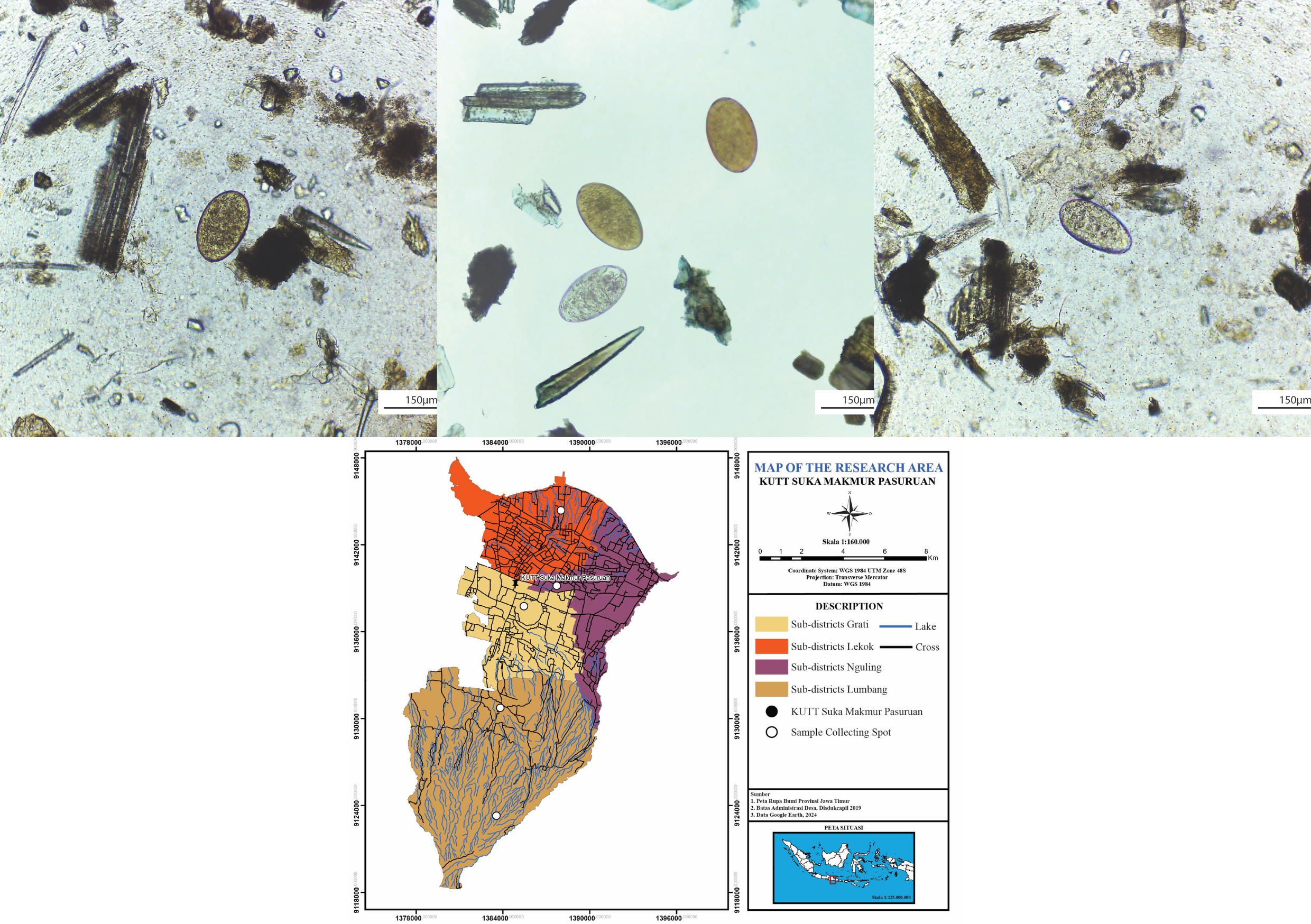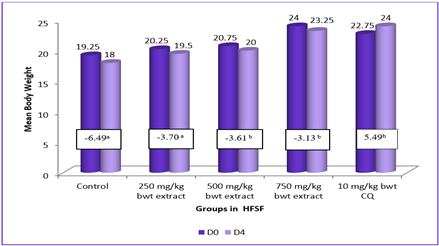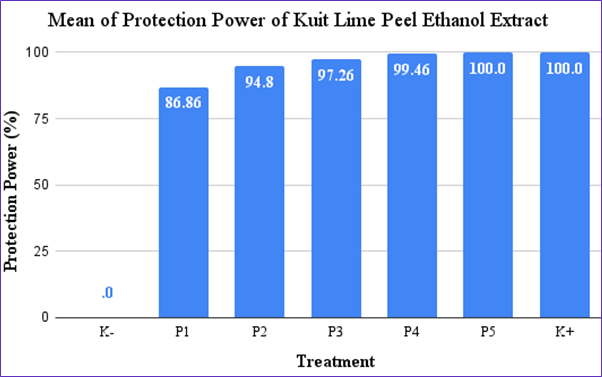Prevalence and Degree Trematoda Infection in Dairy Cattle Friesian Holstein at Koperasi Usaha Tani Ternak Suka Makmur Pasuruan

Downloads
Trematode worm infections in dairy cattle have not been widely reported in various regions in Indonesia. This study aims to determine the prevalence and degree of trematode worm infection in Friesian Holstein dairy cattle at KUTT Suka Makmur, Pasuruan. The research design used survey study and cross-sectional study. The study was conducted in July-September 2023. The number of samples taken was 100, which were selected from proportional random sampling of four sub-districts, namely Grati, Nguling, Lekok, and Lumbang, with the age ranges under a year, 1-2 years, and above 2 years. The sample were examined using the sedimentation method and Flukenfinder® method. Positive samples were further examined using the McMaster method to determine the number of worm eggs per gram of feces. The results of this study obtained a prevalence of 54% with low and moderate degrees of infection. The trematode worm species found through fecal examination were Fasciola gigantica and Paramphistomum cervi. The results of chi square statistical analysis showed that sample examination method and age were related to the prevalence of trematode worms, yet location was not related to the prevalence of trematode worms. The results of kruskal wallis statistical analysis showed that age and location influence the degree of trematode worm infection.
Amam, A. and Harsita, P.A. (2019) ‘Pengembangan Usaha Ternak Sapi Perah : Evaluasi Konteks Kerentanan Dan Dinamika Kelompok’, Jurnal Ilmiah Ilmu-Ilmu Peternakan, 22(1), pp. 23–34. Available at: https://doi.org/10.22437/jiiip.v22i1.7831.
Arbabi, M. et al. (2018) ‘Epidemiology and Economic Loss of Fasciolosis and Dicrocoeliosis in Arak, Iran’, Veterinary World, 11(12), pp. 1648–1655. Available at: https://doi.org/10.14202/vetworld.2018.1648-1655.
Awaludin, A., Nugraheni, Y.R. and Muhamad, N. (2020) ‘Derajat Infeksi Fasciola Sp. Pada Sapi Perah Periode Laktasi’, Seminar Nasional Ilmu Peternakan Terapan, 1(1), pp. 92–96. Available at: https://doi.org/10.25047/proc.anim.sci.2020.13 .
Cattleya, R., Yuwono, E. and Indasati, D. (2023) ‘Prevalensi, Identifikasi, dan Pengaruh Umur Terhadap Trematodiasis pada Kambing di Sumbang, Banyumas’, Prosiding Seminar Nasional Teknologi Agribisnis Peternakan, 10, pp. 119–126.
Ekawasti, F. et al. (2022) ‘Trematode and Nematode gastrointestinal infections in livestock from different geographical regions in Indonesia’, International Seminar on Livestock Production and Veterinary Technology, pp. 255–267. Available at: https://doi.org/10.14334/Proc.Intsem.LPVT-2021-p.25.
Hambal, M., Sayuti, A. and Dermawan, A. (2013) ‘Tingkat Kerentanan Fasciola gigantica Pada Sapi Dan Kerbau Di Kecamatan Lhoong Kabupaten Aceh Besar’, Jurnal Medika Veterinaria, 7(1), pp. 49–53. Available at: https://doi.org/10.21157/j.med.vet..v7i1.2921.
Heraini, D., Purwanto, B.P. and Suryahadi (2016) ‘Perbandingan Suhu Lingkungan Dan Produktivitas Ternak Sapi Perah Melalui Pendekataan Stochastic Frontier (Study Kasus di Peternakan Rakyat KUTT Suka Makmur)’, Jurnal Sains Terapan, 6(1), pp. 16–24. Available at: https://doi.org/10.29244/jstsv.6.1.16-24.
Hidayatullah, W. and Rizkiantono, R.E. (2016) ‘Perancangan Branding Business to Business KUTT Suka Makmur untuk Meraih Pangsa Pasar Baru’, 5(2). Available at: https://doi.org/10.12962/j23373520.v5i2.20896.
Khedri, J. et al. (2015) ‘Prevalence and Intensity of Paramphistomum Spp. In Cattle from South-Eastern Iran.’, Iranian journal of parasitology, 10(2), pp. 268–272.
Kurnia, D. et al. (2022) ‘Prevalensi Trematoda Gastrointestinal pada Sapi di Pasar Ternak Payakumbuh’, VITEK : Bidang Kedokteran Hewan, 12(1), pp. 35–39. Available at: https://doi.org/10.30742/jv.v12i1.102
Kurnianto, H. et al. (2022) ‘Prevalence, Risk Factors, and Infection Intensity of Fasciolosis in Dairy Cattle in Boyolali, Indonesia’, Veterinary World, 15(6), pp. 1438–1448. Available at: https://doi.org/10.14202/vetworld.2022.1438-1448
Larasati, H. et al. (2017) ‘Gastrointestinal Helminths Dairy Cattle Prevalence in Period of June-˗˗July 2016 on Public Farm at Lampung Province’, Jurnal Penelitian Peternakan Indonesia
Mubarok, F., Suratma, N.A. and Dwinata, I.M. (2015) ‘Prevalensi Trematoda di Sentra Pembibitan Sapi Bali Desa Sobangan, Kecamatan Mengwi, Kabupaten Badung’, Indonesia Mediscus Veterinus, 4(1), pp. 48–53
Nugraheni, Y.R. et al. (2018) ‘The Gastrointestinal Parasites Cows on Progo Watershed in Yogyakarta’, Jurnal Imu Peternakan Terapan, 1(2), pp. 46–50. Available at: https://publikasi.polije.ac.id/jipt/article/view/889
Parmawati, R. et al. (2018) ‘Developing Sustainable Livestock Production by Feed Adequacy Map: A Case Study in Pasuruan, Indonesia.’, Tropical Animal Science Journal, 41(1), pp. 67–76. Available at: https://doi.org/10.5398/tasj.2018.41.1.67
Podpečan, O., Hajdinjak, M. and Posedi, J. (2023) ‘Helminth Control as a Part of Animal Welfare Measure Protocol in Grazing Cattle in Slovenia’, Agriculture, 13(5), p. 1038. Available at: https://doi.org/10.3390/agriculture13051038
Reigate, C. et al. (2021) ‘Evaluation of Two Fasciola hepatica Faecal Egg Counting Protocols in Sheep and Cattle’, Veterinary Parasitology, 294, p. 109435. Available at: https://doi.org/10.1016/j.vetpar.2021.109435
Siswanto, S. et al. (2018) ‘Prevalensi Cacing Hati Sapi Perah pada Peternakan Rakyat di Provinsi Lampung’, Jurnal Ilmiah Peternakan Terpadu, 6(3), p. 167. Available at: https://doi.org/10.23960/jipt.v6i3.p167-172
Stevenson, M. (2008) An Introduction to Veterinary Epidemiology. Massey University, Palmerston North, New Zealand: Epi Centre IVABS.
Taylor, M.A.., Coop, R.L.. and Wall, R. (2015) Veterinary parasitology. 4th edn. London: John Wiley and Sons, Inc.
Copyright (c) 2024 Journal of Parasite Science (JoPS)

This work is licensed under a Creative Commons Attribution-NonCommercial-ShareAlike 4.0 International License.
- Every manuscript submitted to must observe the policy and terms set by the Journal of Parasite Science
- Publication rights to manuscript content published by the Journal of Parasite Science is owned by the Journal of Parasite Science with the consent and approval of the author(s) concerned
- Authors and other parties are bound to the Creative Commons Attribution-NonCommercial-ShareAlike 4.0 International License for the published articles, legal formal aspect of journal publication accessibility refers to Creative Commons Attribution-NonCommercial-ShareAlike 4.0 International License (CC BY-NC-SA)
- By submitting the manuscript, the author agrees to the requirement that the copyright of the submitted article will be transferred to Journal of Parasite Science as the publisher of the journal. The intended copyright includes the right to publish articles in various forms (including reprints). journal of parasite science retains the publishing rights to published articles.

































